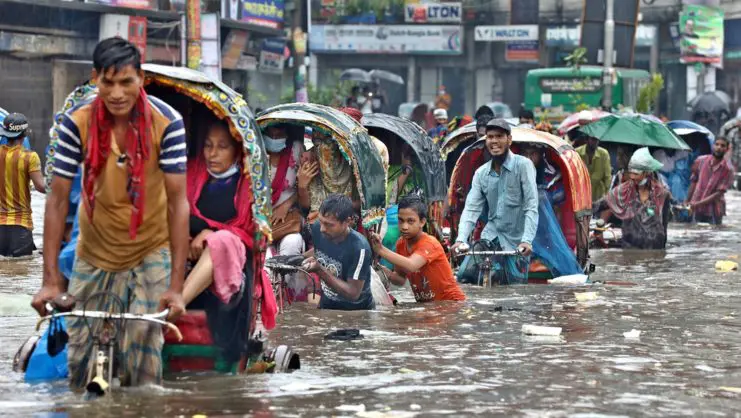Our food systems are breaking the planet – and the climate crisis is breaking our food systems. These connected crises are two of the most important and complex problems the world is facing today, and the subject of the two major conversations the UN has organized in 2021.
At the UN Food Systems Summit in September 2021, the World Food Programme (WFP) issued a wake-up call: 811 million people are going to bed hungry in countries where food systems are unequal, strained, or broken.
The summit put food systems into a wider context, recognizing the globalized and wide-ranging impacts generated by producing, processing, transporting, and consuming food the way we do. These impacts reach deep into our global climate system and require us to look at food systems through the prism of climate change adaptation and mitigation.
Extreme weather events such as heatwaves, storms, floods, and droughts impact food access and stability. Climate stresses such as untimely rainfall, irregularity in changing seasons, rising salinity in soils and groundwater, pest infestations and diseases, and heat stress in crops and livestock undermine food production and affordability. Once food systems are strained by climatic, social, or economic tensions, even smaller disruptions can cause them to break down and make the people involved in them dependent on external support.
However, these strains are not the only way food systems and the global climate are connected. Today’s food systems cause up to a third of global greenhouse gas emissions, which accelerate global heating. This heating then boomerangs in the form of climate extremes which break supply chains, drive food prices and, in many countries, hunger and malnutrition.
At the sharp end of the climate crisis are vulnerable communities who contribute least to the problem but pay the highest price.
Global institutions are now advocating for food systems to become a more integral part of the more general conversation about climate action, and are demanding that climate action be seen as an opportunity to transform unsustainable and vulnerable food systems into more resilient and equitable ones.
Yet, as delegates from more than 190 countries come together in Glasgow for the 26th Conference of Parties to the UN Framework Convention on Climate Change, the topic of food systems is yet to make it into the mainstream conversation at UN climate meetings.
In their luggage, delegates will carry different positions, plans, approaches, and expectations to keep global heating under 1.5°C and adapt to the impacts of a rapidly changing climate. At the sharp end of the climate crisis are vulnerable communities who contribute least to the problem but pay the highest price. Research shows that if global temperatures keep rising to hit the 2° C mark, an additional 189 million people could become food insecure. In a 4°C warmer world, this number could increase by as many as 1.8 billion people. The problem is clear, but not all COP delegates will see food systems as part of the solution.
The challenges faced by international organizations like WFP in this area include difficulties in getting adequate funding to undertake bold action beyond traditional humanitarian and development aid. Donors still need to be convinced to support more systemic approaches, even if experience shows that such investments do yield concrete results.
Strategic dialogue between food institutions and governments has mainly focused on preventative action using climate models, restorative and positive-impact actions, and insurance solutions for smallholder farmers, but how do these three approaches work?
Anticipation
Working on the anticipation of climate hazards has demonstrated how losses and damages in food systems can be avoided, preventing these hazards from becoming disasters. Take Bangladesh as an example, where anticipatory cash transfers to 150,000 people ahead of some of the worst monsoon flooding in decades have enabled people to protect assets and move themselves and their livestock out of harm’s way.
Cash and warning information reached vulnerable families several days before floodwaters did, and as a result, households were 36 percent less likely to go a day without eating during the flood. The costs of the humanitarian response were cut in half; people could sustain their earning potential and did not have to borrow from the costly informal lending market.
Restoration
Communities must also be supported in order to adapt to a changing climate through projects which restore degraded ecosystems that act as natural shields against climate hazards. Combatting land degradation will be a key to ensuring soil is both productive in food production and carbon absorption.
For example, WFP works in Chad’s arid Sahel Belt to establish tree nurseries that produce around 1 million tree seedlings a year. These trees help reclaim degraded land, recharge groundwater tables and capture thousands of tons of carbon dioxide, enabling the production of nutritious food.
Safety nets
Climate risk insurance enables communities to withstand shocks as it provides people with cash payouts following a climate-related disaster. However, insurers can do more than simply pay out to those affected by using their deep understanding of climate risks to help these communities adapt. Advanced analytics techniques need to be used to model the effects of climate hazards on communities over time, and these models could be coupled with activities that have a positive effect.
In Central America’s ‘dry corridor’, spanning El Salvador, Guatemala, and Honduras, communities have been helped to adapt to the impacts of drought and improve livelihoods through income-generating activities such as diversification of crops and the construction of irrigation systems. Helping these communities to mitigate climate stresses by making their food systems more resilient not only helps those directly affected, but also contributes to improving the broken global food system we are fighting to repair.
With solutions such as these, international actors like WFP and others can connect the conversation about climate change adaptation with the conversation about food systems resilience. Food systems transformation, if done right, can accelerate climate action – and conversely, climate action can enable and sometimes even trigger food systems transformation. What it takes is an awareness that the risks and problems we are facing in today’s world are globalized and interconnected – and that the solutions are, too.
© IE Insights.








